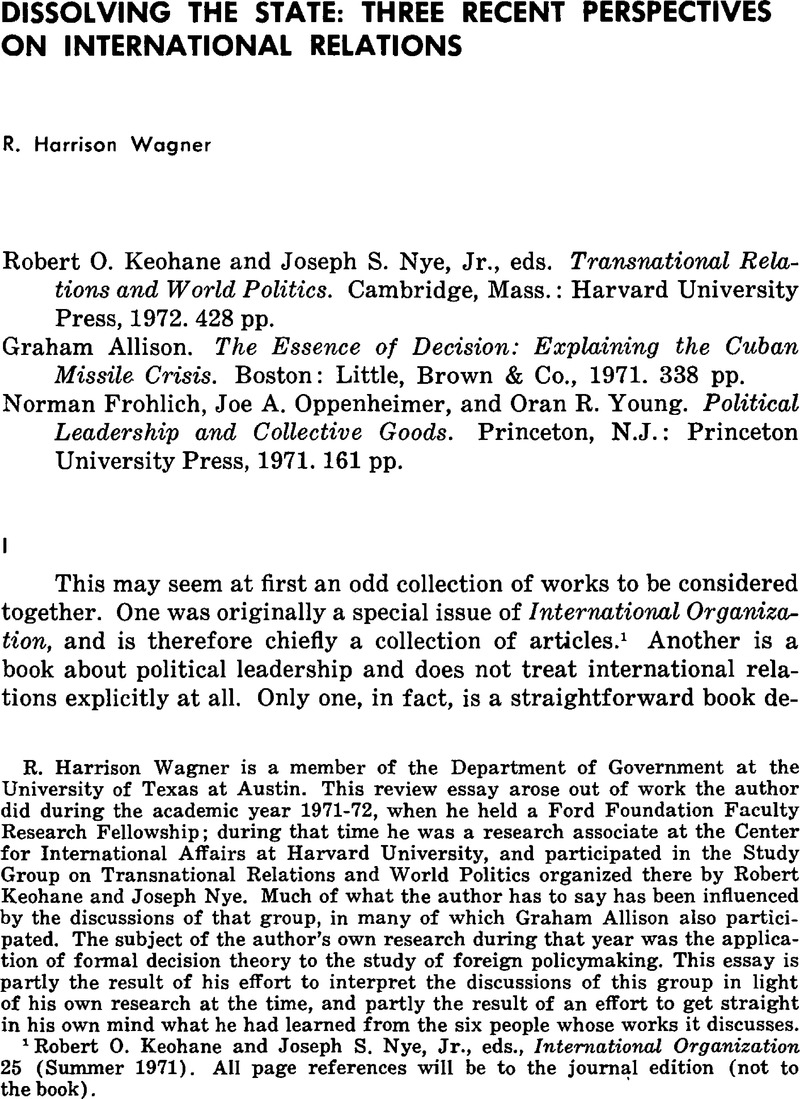Article contents
Dissolving the State: Three Recent Perspectives on International Relations
Published online by Cambridge University Press: 22 May 2009
Abstract

- Type
- Review Essays
- Information
- Copyright
- Copyright © The IO Foundation 1974
References
1 Robert, O. Keohane and Joseph, S. Nye Jr., eds., International Organization 25 (Summer 1971Google Scholar). All page references will be to the journal edition (not to the book).
2 Frohlich, Norman and Oppenheimer, Joe A., “An Entrepreneurial Theory of Politics” (Ph.D. dissertation, Department of Politics, Princeton University, 1971).Google Scholar
3 Keohane and Nye, p. 332.
4 Keohane and Nye, p. 344.
5 Keohane and Nye, pp. 338–39. Emphasis in orginal.
6 Keohane and Nye, p. 337.
7 Keohane and Nye, p. 731.
8 Keohane and Nye, p. 734.
9 See, for example, Keohane and Nye, p. 728.
10 Compare Cohen, Benjamin J., “American Foreign Economic Policy: Some General Principles of Analysis”, in American Foreign Economic Policy: Essays and Comments, ed. Benjamin, J. Cohen (New York: Harper & Row, 1968Google Scholar), Part I.
11 “The Big Influence of Small Allies”, Foreign Policy 1 (Spring 1971): 161–82.
12 Compare Riker's, William discussion of the balance of power in The Theory of Political Coalitions (New Haven, Conn.: Yale University Press, 1962), pp. 160–74.Google Scholar
13 Raiffa, Howard, Decision Analysis: Introductory Lectures on Choices under Uncertainty (Reading, Mass.: Addison-Wesley, 1968Google Scholar); Feldman, Julian and Kanter, Herschel E., “Organizational Decision Making”, in James, March, ed., Handbook of Organizations (Chicago: Rand McNally, 1965), pp. 614–49.Google Scholar
14 Downs, Anthony, An Economic Theory of Democracy (New York: Harper & Row, 1957Google Scholar); and Downs, , Inside Bureaucracy (Boston: Little, Brown & Co. for the RAND Corporation, 1967CrossRefGoogle Scholar). There is also some discussion of this problem in Cyert and March; see Cyert, Richard M. and March, James G., A Behavioral Theory of the Firm (Englewood Cliffs, N.J.: Prentice-Hall, 1963), pp. 284–88.Google Scholar
15 Compare Krasner, Stephen D., “Are Bureaucracies Important?”,Foreign Policy, no. 7 (Summer 1972): 159–79.CrossRefGoogle Scholar Allison sometimes calls his Model III a “bureaucratic politics” model, and sometimes a “governmental politics” model. Some important questions turn on the difference.
16 Another possible basis, of course, is the theory of N-person games. See, for example, Riker, pp. 211–43; and Rapoport, Anatol, N-Person Game Theory: Concepts and Applications (Ann Arbor: The University of Michigan Press, 1970), pp. 303–17.Google Scholar
17 This distinction was first made by Head, J. G., “Public Goods and Public Policy,” Public Finance, 17 no. 3 (1962): 197–221.Google Scholar
18 Samuelson, P. A., “The Pure Theory of Public Expenditure”, Review of Economics and Statistics 36 (November 1954): 387–89.CrossRefGoogle Scholar
19 Olson, Mancur Jr., The Logic of Collective Action: Public Goods and the Theory of Groups (Cambridge, Mass.: Harvard University Press, 1965).Google Scholar
20 Frohlich and Oppenheimer, pp. 71–82. See also the book by Frohlich, Oppenheimer, and Young.
21 For two efforts to interpret collective goods situations as prisoners' dilemmas, see Buchanan, James, The Demand and Supply of Public Goods (Chicago: Rand McNally & Co., 1968), pp. 88–91Google Scholar; and Hardin, Russell, “Collective Action as an Agreeable n-Prisoners' Dilemma”, Behavioral Science 16 (September 1971): 472–81.CrossRefGoogle Scholar
22 Compare Schelling's, comment, “The coordination game probably lies behind the stability of institutions and traditions and perhaps the phenomenon of leadership itself”. Thomas Schelling, The Strategy of Conflict (New York: Oxford University Press, 1963), p. 91.Google Scholar
23 Compare the following comments by Karl Deutsch: “Insofar as members of a stable political community must be able to expect more or less dependable interlocking, interchanging, or at least compatible behavior from each other, they must be able… to predict one another's actions…. Examples of such predictions… might include John C. Calhoun's opposition to the incorporation of any additional large parts of Mexico into the United States, on the grounds that the Mexican people could not be expected to be assimilated by the Americans; and the alleged deliberate limitation by Bismarck, according to Graham Wallas, of his intended German Empire ‘by a quantitative calculation as to the possibility of assimilating other Germans to the Prussian type. He always opposed the inclusion of Austria, and for a long time the inclusion of Bavaria, on the ground that while the Prussian type was strong enough to assimilate the Saxons and Hanoverians to itself, it would fail to assimilate Austrians and Bavarians’”. Deutsch, Karl, Political Community at the International Level: Problems of Definition and Measurement (New York: Doubleday, 1954), pp. 53–54.Google Scholar
24 Frohlich and Oppenheimer, pp. 360–61. In another article, Frohlich and Oppenheimer have attempted to draw some further implications of their work for the study of international politics. See Frohlich, Norman and Oppenheimer, Joe A., “Entrepreneurial Politics and Foreign Policy”, World Politics 24 (Spring 1972) supplement: 151–78.CrossRefGoogle Scholar
25 Frohlich and Oppenheimer, “An Entrepreneurial Theory”, pp. 357–58.
26 Work in progress by Keohane and Nye is directly relevant to these suggestions.
27 For some anecdotal evidence that most actual behavior falls short of these assumptions, see Raiffa, pp. 110–14.
28 Downs, An Economic Theory of Democracy, Parts II and III; Downs,Inside Bureaucracy, especially chapter 14; Lindblom, Charles and Braybrooke, David, A Strategy of Decision (New York: The Free Press, 1963).Google Scholar
- 25
- Cited by




